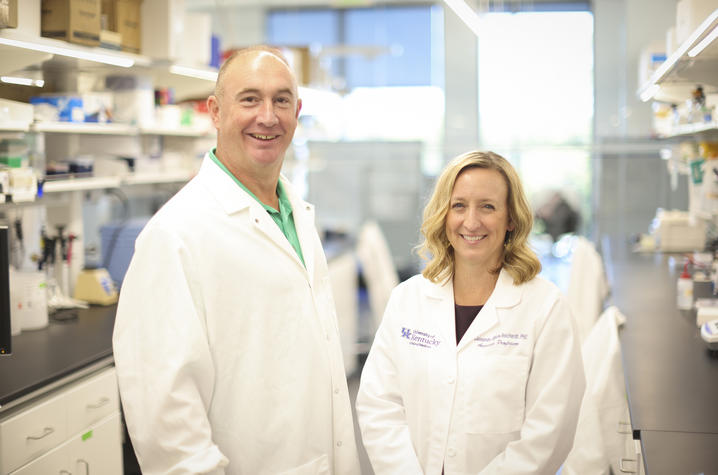UK researchers awarded $2.6 million to study new drug combination driving overdose deaths

Cassandra Gipson-Reichardt, Ph.D., and Terry Hinds, Jr., Ph.D., associate professors in the University of Kentucky College of Medicine’s Department of Pharmacology and Nutritional Sciences, have received a $2.65 million five-year grant from the National Institute on Drug Abuse (NIDA) to support research to understand how xylazine and fentanyl change the brain’s signaling pathways.
Xylazine, a veterinary anesthetic commonly referred to as “tranq,” has recently made its way into the illicit drug supply as a drug adulterant to enhance the effects of fentanyl, a potent opioid that can be lethal even in small amounts. The new drug combination has resulted in a 1,127% increase in xylazine-positive overdose mortalities in the American south from 2020 to 2021, and results in other problematic health effects including tissue necrosis.
This rapid spread of xylazine is also posing new challenges to addressing the opioid epidemic as it decreases the efficacy of naloxone, the life-saving medication that reverses the effects of an opioid overdose.
Gipson-Reichardt and Hinds will study the specific brain circuits that are changed when xylazine and fentanyl are used together and see if these changes are responsible for making naloxone less effective. They have already identified unexpected pathways controlled by the combination that may reduce the actions of naloxone. In their work, they will determine if targeting these pathways are potentially therapeutic.
Their team will utilize advanced PamGene PamStation technology in the Hinds lab to measure activities of hundreds of signaling mechanisms in the brain reward circuitry to identify how the co-use affects pathways and also to identify targets for therapeutic use.
“By studying these processes in detail, we hope to better understand the ways xylazine and fentanyl interact in the brain and how they affect behavior,” said Gipson-Reichardt. “This knowledge could lead us to new strategies for treating people who are struggling with the combined use of these substances and help make naloxone more effective in saving lives.”
These are the only preclinical studies currently funded by NIDA to address the xylazine/fentanyl epidemic, and will be the first to determine neurobiological and behavioral impacts of combined xylazine and fentanyl use and identify treatment targets to reverse xylazine’s effects on fentanyl.
Gipson-Reichardt and Hinds will be collaborating with Kelly Dunn, Ph.D., at Johns Hopkins University to translate findings to inform the public on individual factors that may lead to worse clinical outcomes during withdrawal from the xylazine/fentanyl combination.
Research reported in this publication was supported by the National Institute on Drug Abuse of the National Institutes of Health under Award Number R01DA058933. The content is solely the responsibility of the authors and does not necessarily represent the official views of the National Institutes of Health.
More from this series Research Priorities - Substance Use Disorder
Credits
Words: Elizabeth Chapin (Public Relations & Strategic Communication)
Photo: Mark Cornelison (UK Photo)

